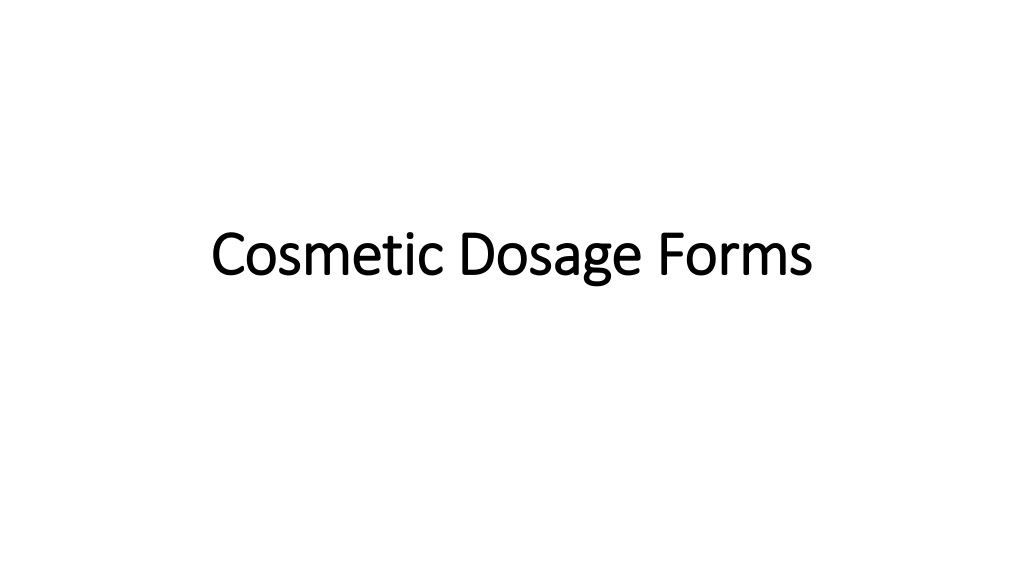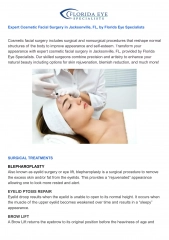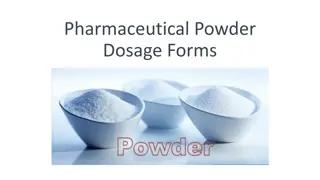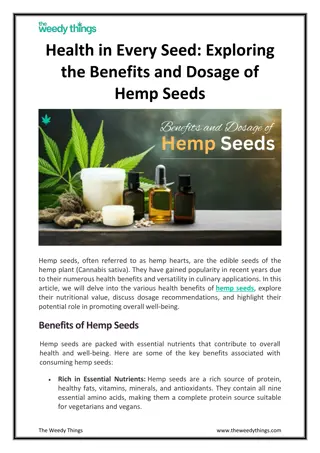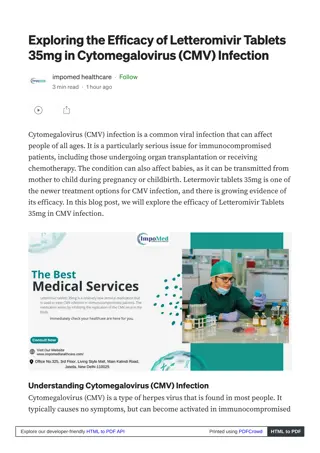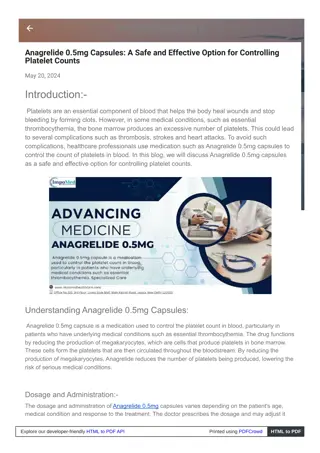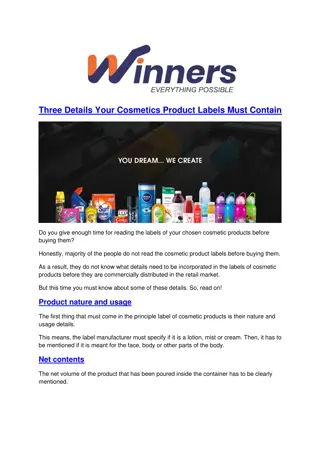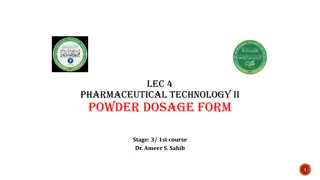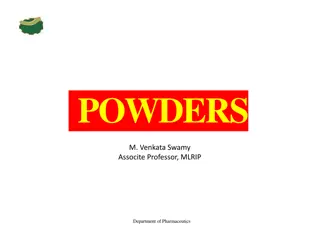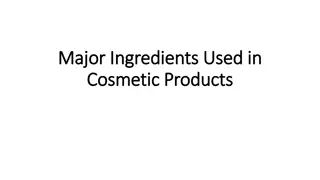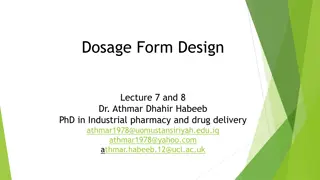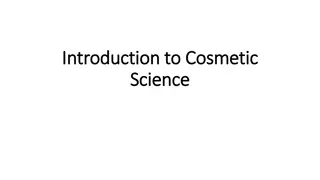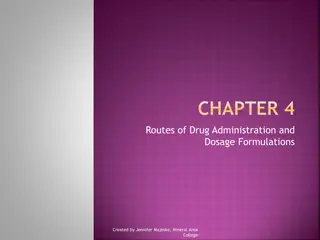Understanding Cosmetic Dosage Forms in the Beauty Industry
Solutions, emulsions, and water-in-silicon formulations are essential cosmetic dosage forms with unique characteristics and applications. Solutions range from water-based to anhydrous, while emulsions offer versatility for delivering hydrophilic and hydrophobic ingredients. Water-in-silicon emulsions provide a non-greasy skin feel, and lotions are low-viscosity emulsions suitable for various skincare products.
Download Presentation

Please find below an Image/Link to download the presentation.
The content on the website is provided AS IS for your information and personal use only. It may not be sold, licensed, or shared on other websites without obtaining consent from the author. Download presentation by click this link. If you encounter any issues during the download, it is possible that the publisher has removed the file from their server.
E N D
Presentation Transcript
Cosmetic Dosage Forms Cosmetic Dosage Forms
Solution is the simplest type of formulation. Water-based (i.e., aqueous) solutions contain water as the vehicle. Examples for water-based solutions include eye makeup remover, hand soap, and many shampoos. Hydroalcoholic solutions contain a mixture of water and alcohol as the vehicle. Examples for hydroalcoholic solutions include hair spray, mouthwash, aftershave cologne, and facial toner. Anhydrous (i.e., waterless) solutions contain ingredients other than water as the vehicle. The solvents can be organic solvent, such as for base coat or nail polish remover. Solvents can also be oily components, such as for bath oils
Emulsions are the most widely used dosage forms in the cosmetic industry due to their advantages over other dosage forms. They have a unique texture and provide a nice skin feel, and they are used as vehicles to deliver both hydrophilic and hydrophobic ingredients Generally, O/W emulsions are chosen for applications that require a relatively small amount of fatty materials, such as for hair conditioners, shaving creams, or facial moisturizing creams. On the other hand, W/O emulsions are preferred when a larger amount of oil is desired in the formulation. W/O emulsions are greasier, leave a longer-lasting residue, and are more water resistant (as they contain oils in the outer phase). W/O emulsions are preferred in diaper rash products
Water-in-silicon (W/Si) emulsions are also important. These formulations provide a unique, nongreasy skin feel and quick drying effect, leaving the skin smooth. Examples for such formulations include facial foundations, cream eyeshadows, and certain sunscreens. Complex types may also be formed, such as water-in-oil-in- water (W/O/W) emulsions, which are basically an emulsion in an emulsion.
Based on their viscosity, usually two types of emulsions are distinguished for cosmetic applications, namely lotions and creams. Lotions are low-viscosity (thin) emulsions behaving as liquids; therefore, they can be poured from a bottle or pumped from a jar. They are designed to be applied without heavy rubbing. Lotions contain a higher amount of water in the continuous phase than creams. they are less greasy and easily washable. Lotions are often referred to as milks and balms. Examples for lotions include facial cleansing milks, liquid foundations, aftershave balms, and non-aerosol sunscreen sprays.
Creams are high-viscosity (thicker), semisolid emulsions. Since creams contain a higher amount of oil phase, they are generally more greasy, even the O/W types. Creams do not flow readily; therefore, they can be packed into a jar or a tube for dispensing. Examples for creams include facial moisturizing creams, leave-in hair conditioners, and sunscreens
Ointment are super thick semisolid products compared to lotions or creams. Ointments have an occlusive nature and provide a seal over the skin. They can contain a small amount of water or can be anhydrous. In the case of anhydrous formulations, the chance for microbiological contamination is low, which is a distinct advantage. However, ointments have a less aesthetic appeal for skin care and dermatology products as they are oily, waxy, greasy, sticky, tacky, and heavy.
They are advantageous for smaller skin areas that are extremely dry and need moisture retention, and for areas that are prone to friction from clothing and need protection. Ointments are often opaque and yellowish due to the high amount of oils. Due to the undesired skin feel, there are only a small number of cosmetic products formulated as ointments. Examples include some hair styling products, and diaper rash ointments.
Paste are very thick semisolid formulations that are difficult to apply and spread over the skin surface due to their high solid content. They are similar to ointments but contain more solids and, therefore, are stiffer. From a cosmetic perspective, pastes as dosage forms can be used as diaper rash treatment products. Additionally, toothpastes are also pastes that are meant to clean and/or polish the teeth.
However, there is a huge difference between regular paste and toothpaste from the vehicle s perspective. Regular pastes are anhydrous formulations, based on a fatty vehicle; therefore, they are highly adhesive to surfaces and hard to remove with water. Toothpastes, on the other hand, are water-based formulations that mix well with the saliva.
Suspension is a dosage form for delivering insoluble solid ingredients in a liquid medium. Based on the type of the liquid vehicle, usually three types of suspensions are distinguished, including the following: Water-based suspensions; Hydroalcoholic formulations, such as certain facial toners; Anhydrous formulations, such as silicone-based antiperspirant sprays, organic solvent-based nail polishes, and any liquid colored cosmetics containing pigments as color additives, such as mascara, liquid eyeliner, and lip gloss.
Thickeners are essential parts of suspensions since they can increase viscosity and, therefore, slow down the rate of sedimentation of insoluble solid particles and increase the systems overall stability The smaller the particle size of the insoluble ingredient(s), the slower the sedimentation. Size reduction can be achieved by grinding the powders using a mortar and a pestle on a laboratory-scale basis or using mills on a larger scale.
Powder (Including Loose and Pressed Powder) Powders are solid dosage forms. Loose powders are freely flowing mixtures of different dry solid chemicals. This dosage form is used for some makeup products, including baby powder and bath salts. Pressed powders are made of a blend of freely flowing powders via compression. Pressed powders are popular for eye shadows, facial powders and blushes as well. Bath bombs are also examples for pressed powders
Capsule From a cosmetic perspective, capsules are always soft gelatin capsules that contain an oily liquid ingredient inside. Examples for such products include bath oil beads and anti-aging serum capsules. Bath oil beads are used in the bathtub. Due to the gelatin, the capsules easily dissolve when they come into contact with bathwater and release their contents into the bathtub. Anti-aging serum capsules usually have a small tab that can be gently twisted or cut to open the capsule. Since soft capsules are easy to squeeze, the product can be get released the shell by gently squeezing it.
Gel is a semisolid dosage form that contains a gelling agent to provide stiffness to a solution or a colloidal dispersion. Gelling agents are synonymous with thickeners, which increase viscosity and provide a complex internal structure Gels may also contain fragrance beads and exfoliating beads, as some skin cleansing gels do. Additional examples for gels include hair styling gels, facial cleansing gels, shaving gels, aftershave gels, after-sun gels, extrudable deodorant and/or antiperspirant gels, and hand sanitizer gels, among others.
Based on the nature of the vehicle, two main types of gels are distinguished, including Water-based formulations, such as facial cleansers; and Hydroalcoholic formulations, such as hair styling gels and hand sanitizers. Gels contain a higher amount of water compared to other semisolid dosage forms. As water evaporates after application, it provides a cooling effect. This can be advantageous in the case of sunburn products when the cooling sensation can also be perceived as an analgesic (i.e., pain reliever) effect, and also in the case of aftershave gels where water and/or alcohol evaporation has a refreshing effect.
Stick is a solid dosage form that is made of waxes and a smaller amount of oils. Examples for sticks include color cosmetics, such as lipsticks, lip liners, and personal care products such as deodorant/antiperspirant sticks. Sticks are advantageous when consumers do not want to touch and apply products with their fingers.
Aerosol are more of a packaging choice than a specific product type. Many of the above-discussed dosage forms can be produced in the form of an aerosol, including lotions, creams, and suspensions, if a proper can, propellant, and nozzle setup is used. Aerosols are easy to use and provide a quick drying effect, which makes them popular for certain applications. Examples for aerosol products include hair sprays, hair mousse, shaving cream, deodorants/antiperspirants, and sunscreens
